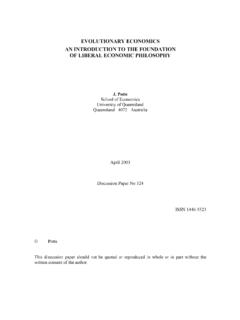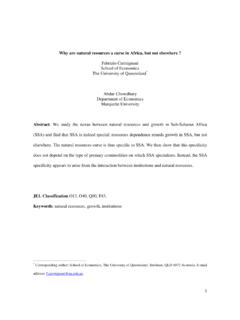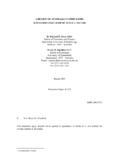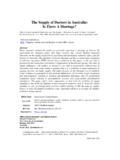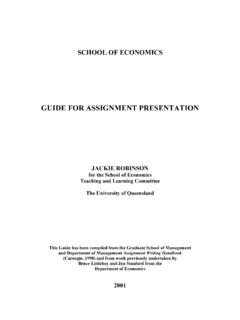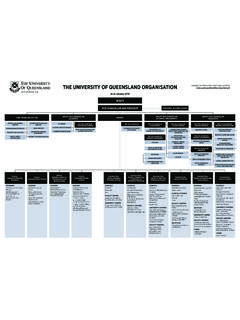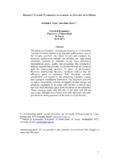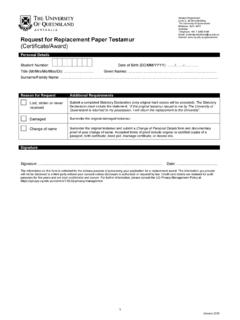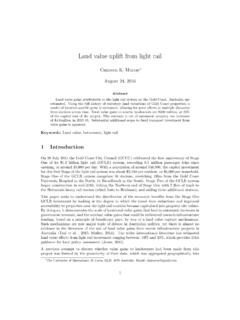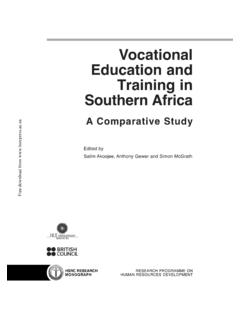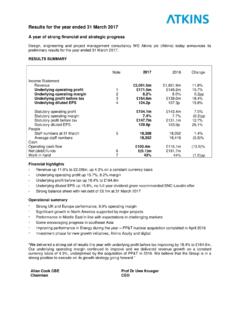Transcription of Avoiding the Resource Curse: The Role of Institutions
1 1 ISSN 1833-4474 Avoiding the Resource Curse: The Role of Institutions Malebogo Bakwena, Philip Bodman, Thanh Le*, Kam Ki Tang School of Economics, The University of Queensland, St Lucia, QLD 4072, Australia * Corresponding author, Tel: 61-7-3346 7053, Fax: 61-7-3365 7299, Email: Abstract This paper investigates empirically whether the natural Resource curse exists and if Institutions can help alleviate this curse. Both cross-country and dynamic panel regressions confirm the important role of institutional quality (measured by either institutional design or institutional performance) in turning natural resources into an economic boon. In terms of influencing the impact of natural Resource abundance on growth, a democratic governance system is better than a non-democratic one, a parliamentary democracy is superior to a presidential democracy and, although a majoritarian system tends to contribute more to growth, it suffers more from the Resource curse than a proportional system.
2 Keywords: economic growth, natural resources, institution design, institution performance, world, Resource rich countries. JEL classifications: O11, O13, O43, O47, O50, O57 2 Avoiding the Resource Curse: The Role of Institutions Abstract This paper investigates empirically whether the natural Resource curse exists and if Institutions can help alleviate this curse. Both cross-country and dynamic panel regressions confirm the important role of institutional quality (measured by either institutional design or institutional performance) in turning natural resources into an economic boon. In terms of influencing the impact of natural Resource abundance on growth, a democratic governance system is better than a non-democratic one, a parliamentary democracy is superior to a presidential democracy and, although a majoritarian system tends to contribute more to growth, it suffers more from the Resource curse than a proportional system.
3 Keywords: economic growth, natural resources, institution design, institution performance, world, Resource rich countries. JEL classifications: O11, O13, O43, O47, O50, O57 1- Introduction Prior to the twentieth century, natural resources, usually comprising primary commodities, played a pivotal role in world trade. Many countries, such as Australia, the United States, and Canada, benefited greatly from significant primary commodity exports in the early stages of their economic development (North and Thomas, 1973; Auty and Mikesell, 1998). However, since the turn to the twentieth century, natural resources have often been treated as less important than labour and capital in generating economic growth and 3 development. In fact, there is a growing body of evidence suggesting that natural Resource abundance may be harmful to the economic development of low and middle income countries.
4 This counter-intuitive result underpins the so-called Resource curse puzzle (Nankani, 1979; Sachs and Warner, 1995, 1997, 2001). Several conjectures have been offered towards explaining the natural Resource curse puzzle. The Dutch disease theory postulates that natural Resource abundance leads to a decline in the production and export of the manufacturing sector which possibly leads to de-industrialisation and lower economic growth. The reason for this is that the export of natural resources generates a substantial inflow of foreign capital which in turn causes an appreciation of the domestic currency and a decline in domestic competitiveness. The damaging consequences are even higher if Resource proceeds are mainly used for consumption instead of investment (Burnside and Dollar, 2000; Sachs, 2007).
5 The rent seeking synthesis, Torvik (2002), suggests that highly Resource abundant countries have a higher incidence of firms engaging in rent seeking activities, leaving only a few to engage in productive ventures. Such rent seeking activities tend to be more popular among firms working in countries that have low quality Institutions since, as explained by Lane and Tornell (1996), Tornell and Lane (1999), and Mehlum et al. (2006a), low quality Institutions are less likely to draw entrepreneurs into productive activity than are good Institutions . In other words, having good Institutions will cure the Resource curse. Most studies that attempt to empirically validate/refute the Resource curse hypothesis are derived from the seminal works by Sachs and Warner (1995, 1997). These studies typically assume the existence of an unconditional Resource curse Resource abundance is correlated with measures of economic development without accounting for other economic , social and institutional factors that may affect this relationship.
6 This approach is clearly not adequate since it does not explain why countries like Botswana, which is rich in diamonds, is 4 not Resource cursed while Sierra Leone, also abundant in diamonds, does seem to be cursed. Similar comparisons can also be made between, for example Norway and Nigeria, the two oil endowed countries. Thanks to the proper utilisation of the oil discovery, Norway has transformed itself from one of the poorest countries in Europe during the early 1900s into the country of highest quality of life today (UNDP, 2009). On the other hand, Nigeria is notorious for its mismanagement of Resource proceeds as well as general corrupt tendencies, hence little economic growth ( Sala-i-Martin and Subramanian, 2003). In view of the fact that earlier studies fail to account for such divergent growth experiences, despite similar Resource type and abundance, more plausible explanations have recently been proposed in the literature ( Mehlum et al.)
7 , 2006b; Arezki and van der Ploeg, 2007; Boschini et al., 2007; Humphreys et al., 2007). These studies have identified institutional quality as the main conduit through which natural Resource abundance affects economic growth. Specifically, natural Resource abundant economies have the potential to escape the Resource curse provided they have good Institutions . Therefore, the conclusion arising from these studies is to abandon the stylised fact that natural Resource abundance is bad for growth (Lederman and Maloney, 2007, p. 33) and, instead, to understand under what circumstances the Resource curse does or does not hold. Unfortunately, whilst this more recent literature provides a richer analysis and promises to be more relevant to policy makers, arguments can be made that it is still deficient in several directions.
8 One deficiency relates to the estimation methods used in the typical empirical analysis. Evidence provided using cross-country Ordinary Least Squares (OLS) approaches to examining the existence of the unconditional Resource curse does not survive the use of panel instrumental variable estimation techniques. For instance, Lederman and Maloney (2002, 2007) allowed for endogeneity among explanatory variables, by using a Generalised Method of Moments (GMM) system estimator in an attempt to add more 5 precision to the estimates and found no evidence of Sachs and Warner s (1995; 1997) Resource Manzano and Rigobon (2001, 2007) also confirmed that Sachs and Warner s results were not robust after using a fixed-effects panel estimation technique. The differences in the results might be expected because cross-country OLS estimation fails to take into consideration endogeneity, heterogeneity and omitted variables biases - problems that are prevalent in empirical growth models but that an instrumental panel estimator is capable of alleviating (Islam, 1995; Hoeffler, 2001).
9 Notwithstanding, the latest literature examining the conditionality (on institutional quality) of the Resource curse tends to use the same cross-country OLS empirical methodology that predicted incorrectly that all Resource abundant economies are destined to be cursed. An empirical examination of the conditional Resource curse hypothesis using such a panel (instrumental) estimator is clearly merited. A second deficiency concerns the natural Resource abundance indicator used in the more recent literature. The problem arises from the perpetual use of Sachs and Warner s (1995; 1997) Resource indicator ( Manzano and Rigobon, 2007; Mehlum et al., 2006b), which is the share of primary exports (sum of exports of primary agriculture, fuels and metals, energy) in GDP or exports.
10 This indicator is problematic in the sense that it merely captures the lack of non- Resource sectors, rather than indicating whether a country is Resource -based or not. For instance, using the indicator for countries such as Norway and Australia that have a high Resource abundance per capita, but also have a relatively large non- Resource sector will incorrectly suggest that they are Resource poor (as reflected by relatively small shares of primary exports). If anything, the dominance of primary exports is an indication of how specialised a country is, and this may be related to the structure of the economy rather than to the Resource curse. The goal of this paper is to address the above mentioned deficiencies in the current literature. In particular, it tests the hypothesis that the effect of resources on growth is 6 conditional on the type and quality of Institutions using a sample of 53 countries over the period of 20 years (1984-2003).
